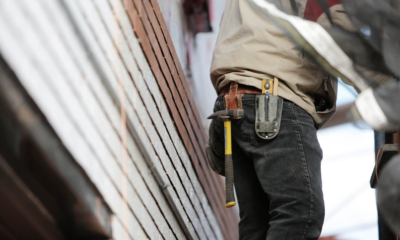Lifestyle
Illuminating Your Outdoor Space: A Comprehensive Guide to Outdoor Lighting
Published
10 months agoon
By
Abdus Subhan
Outdoor lighting refers to the use of illumination outside of buildings and other structures to enhance visibility, safety, aesthetics, and functionality during hours of darkness or in low-light conditions. It encompasses a wide range of applications and is designed to withstand external elements like rain, snow, and temperature fluctuations. Here’s a more in-depth look:
Why Outdoor Lighting Matters
Outdoor lighting, often overlooked, plays a crucial role in various aspects of our daily lives. Whether it’s illuminating a backyard for an evening gathering or lighting up highways for safe transportation, outdoor lighting enhances safety, aesthetics, functionality, and more. Here’s why outdoor lighting matters:
- Safety and Security:
- Pathways and Driveways: Proper lighting ensures that people can safely navigate pathways, driveways, and steps, reducing the risk of trips and falls.
- Deterrence: Well-lit exteriors can deter potential burglars or intruders, as they increase the risk of being seen and caught.
- Traffic Safety: On roads and highways, effective lighting helps drivers see obstacles, pedestrians, and other vehicles, reducing the risk of accidents.
- Aesthetics and Landscape Enhancement:
- Lighting can accentuate architectural features, gardens, and statues, turning them into nighttime focal points.
- The right lighting can create moods and atmospheres, transforming spaces at night. For instance, soft lighting can make a garden feel magical, while bold, bright lights can make a building look majestic.
- Functionality:
- Outdoor events, whether a BBQ, a late-night pool party, or a community festival, rely on good lighting to continue into the evening.
- In commercial settings, outdoor lighting allows businesses to operate or serve customers after dark.
- Ecological Considerations:
- Properly designed outdoor lighting can reduce light pollution, which affects nocturnal wildlife and our ability to see stars in the night sky.
- Modern lighting solutions can be energy-efficient, minimizing environmental impact.
- Economic Impacts:
- Businesses, especially those in the retail and hospitality sectors, benefit from well-designed outdoor lighting. It attracts customers, creates a welcoming ambiance, and can extend business hours.
- Property values can increase with effective outdoor lighting due to enhanced aesthetics and security.
- Wayfinding and Navigation:
- In public spaces, parks, and large complexes, outdoor lighting helps guide people, indicating paths, entrances, exits, and points of interest.
- On roads, lighting supports signage visibility, helping drivers navigate and make informed decisions.
- Community and Social Benefits:
- Public spaces like parks, plazas, and boardwalks become usable and inviting after dark when they are well-lit, encouraging community interaction and activities.
- Festive or specialized lighting during holidays and events fosters community spirit and celebration.
Types of Outdoor Lighting Fixtures
Outdoor lighting fixtures come in various styles and designs, each tailored to specific needs and aesthetics. Here’s a breakdown of some of the most common types:
- Wall Lanterns and Sconces:
- These fixtures are mounted directly on exterior walls and provide both ambient and decorative lighting.
- Commonly used for entryways, patios, and garages.
- Post Lanterns and Pillar Lights:
- Mounted on top of posts or pillars, these lights illuminate pathways, driveways, and entrances.
- They often serve both a functional and decorative role.
- Hanging and Pendant Lights:
- Suspended from above, often from porches, gazebos, or overhangs.
- They create a warm and inviting ambiance.
- Landscape and Garden Lights:
- These are typically low to the ground and are used to illuminate pathways, flower beds, trees, and shrubs.
- Types include path lights, spotlights, and uplights.
- Deck and Step Lights:
- Installed into the structure of a deck or steps, these fixtures provide subtle lighting to outline and make these areas safe.
- They are particularly useful for preventing trips and falls.
- Floodlights and Spotlights:
- High-intensity lights that are used to illuminate large areas or highlight specific features.
- Often used for security purposes, driveways, or to accentuate architectural or landscape features.
- Motion Sensor Lights:
- These fixtures turn on when they detect movement within a certain range.
- Ideal for security and utility purposes, such as lighting up a backyard when someone walks through.
- Bollard Lights:
- These are tall, pillar-like fixtures that are used primarily for pathways, driveways, and commercial premises.
- They provide both illumination and act as visual guides.
- String Lights and Fairy Lights:
- Decorative lights often used for patios, gardens, and festive occasions.
- They create a whimsical and festive ambiance.
- Underwater Lights:
- Designed specifically for use in water features like ponds, fountains, and pools.
- They enhance the aesthetics of water and can also serve as safety features in pools.
Choosing the Right Type of Light
Selecting the right type of light is crucial not just for functionality but also for aesthetics, ambiance, and energy efficiency. Here’s a guide to help you make informed decisions:
- Determine the Purpose:
- Ambient or General Lighting: This is the main source of illumination in any space, whether indoor or outdoor. Typically, ceiling lights, chandeliers, and wall-mounted fixtures are used for this purpose.
- Task Lighting: Designed for specific tasks such as reading, cooking, or makeup application. Desk lamps, under-cabinet lights, and vanity lights are examples.
- Accent Lighting: Used to highlight specific features like artwork, architectural details, or landscaping. Spotlights, up lights, and track lighting are suitable for this.
- Consider the Color Temperature:
- Warm Light (2700K – 3000K): Provides a cozy, warm ambiance. Ideal for living rooms, bedrooms, and dining areas.
- Neutral Light (3500K – 4100K): Suitable for kitchens, bathrooms, and workspaces where clear visibility is essential.
- Cool Light (5000K and above): Emulates daylight and is best for task lighting, basements, garages, and work environments.
- Look at the Color Rendering Index (CRI):
- CRI measures how accurately a light source reveals the true colors of objects. A higher CRI (closer to 100) indicates better color rendering.
- Evaluate Energy Efficiency:
- LEDs: Highly energy-efficient, long-lasting, and available in various color temperatures.
- CFLs (Compact Fluorescent Lamps): More energy-efficient than incandescent bulbs but less so than LEDs. They have a shorter lifespan than LEDs.
- Incandescent Bulbs: Less energy-efficient and have a shorter lifespan. However, they produce warm, inviting light.
- Assess the Fixture and Bulb Compatibility:
- Ensure the bulb type (e.g., E26, E12, GU10) matches the fixture socket.
- Consider dim ability if you want adjustable light levels. Not all bulbs are dimmable, and not all dimmable bulbs work with all dimmer switches.
- Factor in the Room Size and Ceiling Height:
- Larger rooms or rooms with higher ceilings may require more potent light sources or multiple fixtures to achieve adequate illumination.
- Think About Aesthetics and Style:
- The design, material, and color of the light fixture should complement the room’s décor and style.
- Consider the shape and size of the bulb, especially if it’s visible.
- Safety and Special Requirements:
- For wet or damp areas like bathrooms or outdoors, choose fixtures and bulbs rated for those conditions.
- For task-intensive areas, ensure the lighting doesn’t produce shadows or glares.
- Budget:
- While it’s essential to invest in quality lighting, there are options available for every budget. LEDs, for instance, might have a higher upfront cost but save money in the long run due to their energy efficiency and longevity.
Recent News


4 Amazing Trips for Your Family
Choosing somewhere for a family vacation that would pique the attention of adults and kids alike can be a fun...


Customising Your Makeup with Blendable Blush Options
In cosmetics, one’s face is a canvas for self-expression and creativity. Among the myriad of products available, blush is a...


The Benefits of Regular Home Maintenance
Regular home maintenance is essential for maintaining and even raising the value of your house. A proactive approach to repairs...


Understanding the Importance of SEO in Adelaide
In the digital marketplace, Adelaide businesses are in a continuous contest to gain the attention of their target audiences. With...


Breaking Down the Numbers: Understanding the Average Traveling Nurses Pay
The open road, adventure, and the chance to heal – travel nursing promises an undeniable allure. But amidst the excitement,...


Dealing with Oily Skin in Summer: Tips and Tricks
As the temperature rises, those with oily skin often face an additional challenge—maintaining a clear and balanced complexion. Excess oil...


Mountain Wedding Ideas for 2024
A mountain wedding is a stunning choice for couples who cherish nature and desire a distinctive wedding experience. Whether you...


3 Of The Best Ways To Keep Your Salon Clean
It is of the utmost importance to ensure that a salon is kept scrupulously clean, not just for the sake...


3 Reasons You Should Get Blood Tests Every Year
Regular blood tests are essential for preserving general health and identifying potential problems early on. Medical professionals can evaluate your...


How to Make Your Next Crafts Project Pop
Crafting is a creative outlet that allows individuals to express themselves through various mediums such as paper crafts, sewing, painting,...
